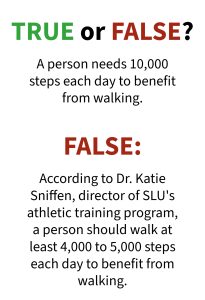When Ed Bolton, chemistry teacher, noticed he was getting tired during the middle of the day, he didn’t reach for caffeine or even take a quick nap.
He walked.
Bolton began walking every day during his plan period with other teachers.
“You just find somebody who has the same off period and make a little group and go out,” Bolton said.
Over the years, Bolton has walked with Ryan Bixby, former MHS chemistry teacher; Jocelyn Fretwell, language arts teacher; and Jason Winter, choir teacher. This year, Bolton walks with language arts teachers Laura Marie Coverstone and Nicole Scherder for 20 minutes during their third hour plan period.
Bolton said walking helps reset his brain.
“Doesn’t really seem to matter what the conditions are out there, but stepping away for a minute really helps you center yourself so you come back and you’re a lot more able to deal with whatever teaching brings you next,” Bolton said.
Last year, Bolton averaged 21,000 steps a day. He said he likes to be active because the more active he is, the happier he feels.
“I try really hard to be in constant motion,” Bolton said.

To experience the basic benefits of walking, a person doesn’t need to walk 21,000 steps a day like Bolton, Dr. Katie Sniffen, director of the athletic training program at Saint Louis University , said.
Dr. Sniffen said people who walk at least 4,000 to 5,000 steps a day experience benefits such as cardiovascular health, improved balance and coordination, stronger bones from repeated weight bearing and increased immune function.
Walking also decreases cortisol levels, which leads to reductions in stress and anxiety and triggers the release of endorphins, Dr. Sniffen said.
“Time spent walking also creates time and space for mental processing and problem solving,” Dr. Sniffen said.
For athletes, walking can be a form of recovery.
“An active recovery like walking is going to help them physically recover from the really intense bout of exercise better than laying around,” Dr. Sniffen said.
To incorporate more walking into their daily routine, a person can park their car farther away from school or work and pair walking with other activities such as taking phone calls or listening to music, Dr. Sniffen said.
“I subscribe to the philosophy of movement is medicine, so the more we move throughout the day, we’re setting ourselves up to experience those health benefits a little bit more consistently,” Dr. Sniffen said.
Peter Nicastro, freshman, walks to and from school every day. His walk takes 15 minutes one way, and Nicastro said he plans to walk to school all four years of high school.
“It’s just a good way to get exercise and talk with my friends,” Nicastro said.
Nicastro said more people should walk.
“It’s a great way to get out and experience your neighborhood and the world around you,” Nicastro said.





